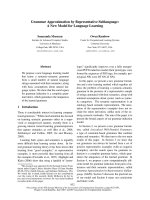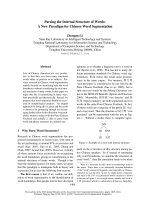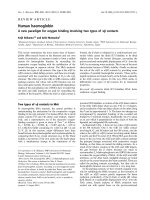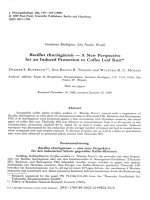Biofeedback Via Telehealth A New Frontier for Applied Psychophysiology
Bạn đang xem bản rút gọn của tài liệu. Xem và tải ngay bản đầy đủ của tài liệu tại đây (127.14 KB, 11 trang )
University of Nebraska - Lincoln
DigitalCommons@University of Nebraska - Lincoln
US Army Research
U.S. Department of Defense
2001
Biofeedback Via Telehealth: A New Frontier for Applied
Psychophysiology
Raymond A. Folen
Center of Excellence in Professional Psychology, Department of Psychology, Tripler Army Medical Center,
Honolulu, Hawaii
Larry C. James
Walter Reed Army Medical Center, Washington, District of Columbia
Jay E. Earles
Center of Excellence in Professional Psychology, Department of Psychology, Tripler Army Medical Center,
Honolulu, Hawaii
Frank Andrasik
Institute for Human and Machine Cognition, University of West Florida, Pensacola, Florida
Follow this and additional works at: />Part of the Operations Research, Systems Engineering and Industrial Engineering Commons
Folen, Raymond A.; James, Larry C.; Earles, Jay E.; and Andrasik, Frank, "Biofeedback Via Telehealth: A
New Frontier for Applied Psychophysiology" (2001). US Army Research. 5.
/>
This Article is brought to you for free and open access by the U.S. Department of Defense at
DigitalCommons@University of Nebraska - Lincoln. It has been accepted for inclusion in US Army Research by an
authorized administrator of DigitalCommons@University of Nebraska - Lincoln.
Applied Psychophysiology and Biofeedback, Vol. 26, No. 3, 2001
This article is a U.S. government work, and is not subject to copyright in the United States.
Biofeedback Via Telehealth: A New Frontier
for Applied Psychophysiology1
Raymond A. Folen,3,5 Larry C. James,4 Jay E. Earles,3
and Frank Andrasik2
Psychophysiological diagnostic and therapeutic methods, to include biofeedback, have been
found to be empirically effective in the treatment of a variety of physical disorders. In many
areas of the country, however, certified biofeedback practitioners are not well distributed,
limiting patient access to this treatment modality. Psychologists at Tripler Army Medical
Center have pioneered efforts to develop and provide these needed services via a telehealth
venue. Such capability significantly improves access to care, particularly for patient’s located at considerable distance from the provider. As the telecommunications infrastructure
in rural and remote areas is often quite basic, such a system must be capable of operating
within these limited parameters. The system developed by the authors provides real-time
video and audio interactivity and allows the therapist to monitor and control biofeedback
equipment located at the remote site. The authors discuss the clinical applications, the
technology, and relevant practical and ethical issues.
KEY WORDS: biofeedback via telehealth; telehealth; telemedicine; behavioral telehealth.
Telehealth, the new term for what was previously called telemedicine, is the use of
telecommunications to provide health information and care across distance (Nickelson,
1998). Begun in the late 1950s at the University of Nebraska, the use of telecommunications
technology to provide primary and specialty health care developed slowly but steadily
during the 1960s through the 1980s, and has since grown exponentially over the last 5 years
(Armstrong, 1998; Bashshur, Sanders, & Shannon, 1997; Coiera, 1997; Darkins & Cary,
2000; Jerome et al., 2000). In the medical and mental health arenas, this technology has
been used primarily for diagnostic and assessment purposes, although recent attention has
focused on the provision of treatment services as well.
1 The
views expressed in this paper are those of the authors and do not reflect the official policy or position of the
Department of the Army, Department of Defense, or the U.S. Government.
2 Institute for Human and Machine Cognition, University of West Florida, Pensacola, Florida.
3 Center of Excellence in Professional Psychology, Department of Psychology, Tripler Army Medical Center,
Honolulu, Hawaii.
4 Department of Psychology, Walter Reed Army Medical Center, Washington, District of Columbia.
5 Address all correspondence to Raymond A. Folen, Department of Psychology, Tripler Army Medical Center,
Honolulu, Hawaii 96859; e-mail:
195
1090-0586/01/0900-0195$19.50/0
C
2001 Plenum Publishing Corporation
196
Folen, James, Earles, and Andrasik
More recently, the term behavioral telehealth has begun to define the use of this technology in behavioral health care. Studies are currently underway to evaluate the feasibility
and efficacy of providing clinical assessment and treatment services to patients at locations
far removed from the clinician. Some of the programs currently being evaluated include
two-way videoconferencing as the medium for providing obesity program follow-up, as
well as the use of interactive web pages for patients to relay follow-up data to the clinician. Six-month results reveal that patients who receive follow-up services via telehealth
have approximately the same percentage of body weight loss (7.0%) when compared to
patients who receive in-vivo follow-up (7.5%; James & Folen, 1999). Studies are currently
underway to assess telehealth versus in-vivo treatment equivalence in neuropsychological
assessment, hypnotherapy, and tobacco cessation intervention.
The federal government and private health care systems are investing considerable resources in furthering the use of emerging technologies in health care (cf. c.
amedd.army.mil). The goal is to increase patient access to primary and specialty care, as
well as enhance the clinician’s ability to acquire expert assistance with difficult clinical
issues. Access to health care is a particular problem for those in rural settings, and telehealth is viewed as a mechanism for enhancing this capability. As the health care field and
society in general develop a greater appreciation and awareness of mind–body integration,
the need for interventions that effectively utilize these components in treatment is increasing. Biofeedback is one such application, where monitoring instruments are used to detect
and amplify internal physiologic processes, then provide this information to the patient via
auditory and visual feedback, allowing the patient to bring these processes under conscious
control.
As biofeedback continues to demonstrate its utility in the treatment of a variety of
physical conditions, clinicians are more likely to incorporate this treatment modality in
the services being offered to the patient (Schwartz, 1995). Currently, the Biofeedback
Certification Institute of America reports that there are 1,500 clinicians certified to provide
biofeedback services in the United States. Most are located in urban areas, and the availability of this highly specialized service, like with many medical specialties, is severely
limited in rural and lower socioeconomic (SES) settings.
At Tripler Army Medical Center, located on the Hawaiian island of Oahu, there are four
psychologists trained in biofeedback. All are located at the medical center. Although this is
often adequate to meet the needs of those federal health care beneficiaries located on Oahu,
the Tripler catchment area covers the active duty military, their family members, and Pacific
Islanders located in an area greater than 50% of the earth’s surface. Flying the patient into
Honolulu and providing the housing required for the 6–8-week period typically required
for biofeedback training is prohibitively expensive. As a result, the Tripler Behavioral
Medicine staff began to identify alternative methods for providing these services to distant
patients.
NASA was the first institution to develop the use of telemetry to monitor physiological
signals in order to determine the state of health of the astronaut in space. Their highly
specialized equipment and programs monitor body temperature, heart rate, blood pressure,
and a variety of other physiologic indicators, using sophisticated wireless systems. Scientists
at the Life Sciences Laboratory have developed astronaut suits that incorporate a number
of sensors with an attached light emitting diode (LED) biofeedback readout (Cowings,
Toscano, Kamiya, Miller, & Sharp, 1985). The astronauts utilize this information to control
Biofeedback Via Telehealth
197
space sickness and orthostatic hypotension. This information is stored on a data belt worn
by the astronaut and relayed back to the NASA scientists.
For most clinicians, the specialized equipment offered by NASA requires a level of
technology and a budget far beyond what one can afford. In addition, the vast majority
of remote sites lack the communications infrastructure to support such an operation. In
a few highly selective rural sites, high-speed/high-bandwidth phone lines and broadcast
quality interactive video communication equipment are available. However, at this time, the
existing infrastructure in most rural communities will only support the telecommunications
bandwidth available with standard phone lines.
SYSTEM DEVELOPMENT
With these telecommunication limitations in mind, we set out to determine the feasibility of providing remote biofeedback services utilizing equipment that placed a minimal
demand on the communications capability of the remote site. The system designed also
needed to be accessible to the patient, cost-effective to the clinician, reliable under a variety
of conditions, and functionally capable of providing the equivalent of on-site biofeedback
services. Thus, real-time visual and audio communications were required, as well as the
capability to acquire, store, view, and manipulate the physiologic signal data in real-time.
Real-time combined simultaneous visual and audio communications have recently
undergone major technological advancement, to the point that excellent audio and acceptable
video signals can be sent over standard phone lines. The commercially available equipment
selected for our project was the “8 × 8” VC105 set-top videophone developed by ViaTV
(www.viatv.com). Other units (cf. www.leadtek.com) that include new refinements are
also available commercially. All are designed to work over a single phone line. The unit
used in our project attached to a standard TV and utilized a standard telephone for audio
and control functions. It has a built-in high resolution color camera and has a maximum
refresh rate of 15 frames per second (fps). Maximum data transmission speed is 33.6 K,
although connections as low as 19.2 K provide an adequate video display. The unit works
by compressing the video and audio signals so that they can be sent through the phone line
at a rate that allows for an adequate refresh rate. It uses what is referred to as the H.324
standard (International Telecommunications Union), which specifies a common method for
video, voice, and data to be shared simultaneously over a standard phone line.
To establish a videophone call, the sender and receiver must have H.324 compatible
videophone units turned on at their respective site. One party then dials the other using a standard phone attached to the videophone. Once a connection is established, one party presses
a key on the phone and the two videophones link up. This process takes approximately
60 s. No other operator intervention is required, and both parties can see and communicate
freely with each other. The procedure to establish a connection is not complicated, but
there are some drawbacks, albeit manageable, in the use of this low-bandwidth technology.
Picture quality is not up to broadcast standards, and excessive movement will cause the
picture to briefly “pixilate,” or distort. Therefore, it is best to keep movement to a minimum. Adequate lighting is also necessary for the transmission of maximum visual detail. A
telephone with a built-in full-duplex speakerphone is highly recommended for hands-free
communication.
198
Folen, James, Earles, and Andrasik
With this functional audio–visual communication system in place, developing a system to control the biofeedback equipment proved to be a more formidable challenge. We
initially considered a system that would send raw data from the remote site over the phone
to the host computer, which would process the data and then send the signal back to a
visual display at the remote site. This proved to be a highly complicated process that required tremendous “bandwidth” (i.e., far more than standard phone lines will allow). We
then decided to set up the biofeedback system (computer and biofeedback equipment) at
the remote site. Using commercially available “remote control” software, we were able
to control the remote computer. This setup was advantageous for a number of reasons.
First, it allowed all computer-intensive activities (signal acquisition, processing, data collection, display) to occur at the remote site. The only signals required to be sent to the
host were those necessary for the computer display. The only signals required to go back
to the remote were those necessary to control the remote computer (basic mouse and keyboard commands). A number of remote control products are commercially available. Most
are quite reliable, as was the product used in our project (pcAnywhere32, Version 8.0
[www.symantec.com]). To properly work with the biofeedback equipment, we found it
necessary to use 100% Windows-based biofeedback software. For a number of technical reasons, biofeedback systems that were DOS-based were found to be completely incompatible
with the remote control software. This was also true for DOS-based biofeedback programs
running in a Windows environment. One system (and by the time of publication there may be
others) found to meet the project criteria was the ProComp+ system developed by Thought
Technology (www.thoughttechnology.com). The ProComp+ system uses the Biograph software package and is 100% Windows-based. Figure 1 illustrates the complete equipment
setup.
Fig. 1. Illustration of Telehealth Biofeedback Equipment.
Biofeedback Via Telehealth
199
PRELIMINARY FINDINGS
We have utilized the ProComp+ system with a number of patients. Initially, we tested
the viability of the system in two separate rooms at the medical center. Connections were
reliable and mean patient satisfaction was high (8 on a scale of 1–10). Patients were able
to produce physiologic changes in the desired direction. Figure 2 illustrates temperature
changes in two patients during the first 15 min of biofeedback following adaptation to
room temperature. Patient 1 was a 38-year-old, married, Caucasian female U.S. Navy petty
officer who was referred to the Behavioral Medicine Service for the treatment of migraine
headaches without aura. She had an 18-year history of one migraine headache per month
with a doubling in the frequency of headaches in the previous 3 years. The biofeedback
via telehealth session was her sixth session of biofeedback treatment. Patient 2 was a
35-year-old, married, Caucasian female U.S. Navy petty officer who was referred to the
Behavioral Medicine Service by the Neurology Service for the treatment of chronic daily
headaches. She had a 4-month history of daily headaches. The biofeedback via telehealth
session was her fifth session of biofeedback treatment.
In December of 1999, we established remote stations at the U.S. Army 121 General
Hospital in Seoul, Korea, the U.S. Navy General Hospital in Yokosuka, Japan, and the
U.S. Navy General Hospital in Guam. In each location, connections have been very reliable
and patients are currently receiving biofeedback services for a variety of conditions. At this
time, a study to more objectively evaluate the equivalency between telehealth and in-vivo
treatment is underway.
One important practical finding has to do with the cost of providing services. We
have determined that the total system requirements for establishing a remote biofeedback
capability are as follows: one H.324 compatible videotelephone at each site, one TV and
Fig. 2. Temperature change demonstrated with autogenic training during Session 6 with a patient with
migraine, Patient 1, and during Session 5 with a patient with chronic daily headache, Patient 2.
200
Folen, James, Earles, and Andrasik
telephone at each site, biofeedback equipment and software for the remote site, Pentium
computer with modem for both sites, and remote-control software for both sites. Total cost
for this system, not including the TVs or standard phones, was approximately $9000. The
majority of that cost was for the biofeedback equipment and biofeedback software. Included
in the total cost, the price for each videophone was approximately $450. At Tripler, standard
in-vivo treatment involves the expense of transporting the patient from the remote site, as
well as housing of the patient for the duration of treatment. These peripheral expenses cost
approximately $4500 to treat a patient over a 6-week period. Total equipment cost has been
recovered with the treatment of two patients. Thus, biofeedback via telehealth can be an
extremely cost-effective means of treatment.
PRACTICAL AND ETHICAL CONSIDERATIONS
Other than basic biofeedback room environmental factors, the only infrastructure requirements for the remote site are two single phone lines (one for the videophone and one
for the computer). The only other technical requirement at the remote site is the minimal
training of a technician, sufficient for them to competently attach the sensors to the patient,
turn the equipment on, and answer the phone. At that point, the practitioner has full control
of the videocommunications and biofeedback equipment. The clinician can see and talk
to the patient, while reviewing the computer display that is simultaneously being seen by
the patient. The session data can be reviewed with the patient, and raw data stored on the
remote computer can be easily downloaded to the host computer for subsequent analysis.
The technology utilized for remote biofeedback training can also be used to control any
hardware and software that is Windows-based. For the clinician considering implementing
remote treatment services of this kind, there are a number of practical and ethical issues to
be considered as well.
Equipment Costs
Until recently, the capital investment required to implement telehealth projects was
prohibitive for smaller facilities. The more expensive telehealth systems can range in price
from $20,000 to over $100,000. For these expensive models, a full-time technician and
well-controlled environments are required in order to adequately maintain, monitor, and run
such equipment. There is a natural tendency, particularly if funds are available, to purchase
the “better” system. A more useful approach is to identify the minimum requirements
necessary to provide the service and match that with the infrastructure that currently exists. In
addition to significantly lower equipment costs, having minimum equipment infrastructure
requirements allows for the greatest flexibility in establishing remote treatment sites.
Comfort With the New Technology
Despite recent advances, the technical aspects of telehealth can be intimidating. As a
result, some professionals may be discouraged from participating in these programs. Clearly,
the technology is such that a certain competency is required. For the equipment described
Biofeedback Via Telehealth
201
in this paper, however, a basic understanding of telephones and computers is sufficient. A
willingness to learn and experiment with this new technology will help sustain the novice
practitioner through the learning curve.
Exclusion Criteria for Patient Participation
Patients who are neurologically impaired may have difficulty incorporating the new
learning necessary to respond via the telehealth medium. Some patients who have visual–
spatial lesions or other right hemisphere disorders may have difficulty orienting themselves
to the equipment. Although conversing with others is a well-learned behavior, talking to
someone through a video display is not. Further, those with visual impairments may have
difficulty recognizing facial expressions through the poorer quality VTC images. Image
quality is dependent on modem speed, something that can be affected by distance and
“dirty” phone lines. Thus, the images projected on to the television monitor may vary in
quality, the degree of pixilation, and audio–visual dysynchrony.
Exclusion criteria would also include patients who are psychotic or suicidal. Despite
careful screening, the possibility of a serious psychological problem presenting itself at
some point during treatment still exists. For this reason, clear and reliable backup emergency
procedures should be in place prior to conducting treatment or evaluations via telehealth.
Time Zone Differences
Most behavioral telehealth occurs within a few time zones of each site, although
services have been provided as far as halfway around the globe. The Tripler project provides
treatment to patients in Guam, Japan, and Korea, considerable distances from Hawaii.
This may have a limiting effect on the availability of appointment times. For example, an
appointment scheduled with a patient at 3:30 p.m. on Tuesday in Japan requires the clinician
in Honolulu to be working at 8:30 p.m. on Monday.
Consent and Privacy Concerns
Norton, Lindborg, and Delaplain (1993) have provided some guidance on the issue of
patient confidentiality/privacy and telemedicine. They have developed a consent form that
provides the patient with rights to limit what is seen by others, explains the limitations to
privacy inherent in the medium, and asserts the patient’s right to discontinue the telecommunications activity at any time. Following this model, it is recommended that patient
consent be secured prior to the video consultation. While security issues are of particular
concern with internet telecommunications, the system described in this paper does not have
the threats to security inherent in the internet, as all communication occurs over relatively
secure phone lines. An example of a telehealth consent form is given in the Appendix.
The In-Vivo Bias
Allaert and Dusserre (1995) assert that the in-vivo physical examination is always
preferable to examination by “tele-assistance.” Moreover, they argue that “the excessive use
202
Folen, James, Earles, and Andrasik
of tele-assistance when there is neither an emergency nor medical isolation is dangerous
because it affects the integrity and quality of the medical act.” We have found no data to
support this assertion. Although it may appear that face-to-face contact is preferred, no
well-controlled comparison of treatment modalities has been reported. In fact, with some
patients, we have observed increased attention and comfort with the therapeutic process
when the patient was switched to a telemedicine venue.
Licensure Across State Lines
Crump and Pfeil (1995) and Nickelson (1996) discuss the problems associated with
practicing telehealth across state lines. Despite Medicare regulations supporting the use of
telehealth technology, many states continue to prohibit providers from “crossing” state lines.
At least one state has passed legislation expressly prohibiting telemedicine by providers
located in another state. Violation of a state practice regulation, according to many professional organizations, is a violation of their ethical code. Anticipating this problem, some
professional, state, and national associations are actively supporting telemedicine guidelines
and uniform state licensing laws.
One should contact the state license board where telehealth is to be practiced in advance.
Justification may be required in order to acquire a “telehealth waiver” to practice.
Hospital Credential Issues
Within a state, a provider of telehealth services treating a patient at a remote hospital
may need to attend to credentialing issues at the remote hospital site. These issues are
potentially complicated and may need the attention of hospital practice boards. All providers
seeking to conduct telehealth services are encouraged to secure courtesy staff privileges at
the representative site. In the absence of such privileges, the provider may need a colleague
at the remote hospital to take overall responsibility for the patient’s care.
Liability Issues
There are few, if any, legal precedents established yet for behavioral telehealth practice.
The use of this medium may increase one’s legal exposure, particularly in cases where an
undesired treatment event occurs.
Insurance Reimbursement
The provision of treatment via telehealth is relatively new, and the vast majority of
insurance carriers have not adequately developed reimbursement policies for such services.
Medicare is a notable exception, although it appears that problems with this enabling legislation are still being resolved. There are reports that some insurance companies in the
northern United States are reimbursing for telehealth services. Major marketing and lobbying efforts, as well as enabling legislation, will be needed to engender recognition by
HMOs and insurance companies.
Biofeedback Via Telehealth
203
DISCUSSION
Biofeedback has undergone many technological changes and challenges since its inception. The field has moved from stand-alone equipment to the computer driven packages
available today. Historically, biofeedback practitioners have been quite responsive to technologic changes designed to improve patient care. As the information age fuels technological
advancements, a new extension for the provision of biofeedback services is now available.
Up to this point, biofeedback has relied on the patient and provider being in the same location. This has severely limited access and continuity of care for those unable to come to
the biofeedback professional.
The implications of telehealth biofeedback are far-reaching. By establishing satellite
locations complete with equipment and minimal technical support, urban and rural patients
may now receive services at distances that previously would have prevented biofeedback
treatment. A whole new population of patients who in the past were unable to present for
biofeedback treatment because of a lack of facilities or trained professionals now have
access to care. Patients lost to premature termination will now be able to obtain follow-up
treatment from a distance.
The implications of this application may extend well beyond the circumscribed area
of biofeedback. Many medical assessment and treatment procedures that rely on Windowsbased computers may be appropriate candidates for telemedicine. Services that primarily
involve monitoring, or where clinical skills focus on visual/verbal communication and
computer display and control, may best lend themselves to remote applications. When
actual physical contact with the patient can be managed by a technician, the intervention or
assessment procedure can often be managed remotely (Strode, Gustke, & Allen, 1999).
At this point, a number of questions remain unanswered. Although our preliminary
findings suggest that telehealth biofeedback may be equivalent to in-vitro treatment, studies
to support this assertion need to be conducted. Standards for patient care also need to be
established, as the practitioner has a more limited ability to control aspects of the treatment
encounter. For example, if one is faced with a suddenly suicidal patient, the need for
adequate backup at the remote site becomes patently obvious. There are also concerns
about licensing requirements and insurance reimbursement, issues that the entire telehealth
community is struggling with. In several early studies, behavioral telehealth has proven to
be cost-effective and efficacious and significantly improves patient access to care. For these
reasons, the benefits of telehealth will likely far outstrip the growing pains associated with
the emerging technology.
APPENDIX: TELEHEALTH CONSENT FORM
Date:
Patient Name:
SSN:
The reasons for this telehealth treatment /consultation have been discussed with me. I
understand that the reason for my treatment through telehealth is(are):
204
Folen, James, Earles, and Andrasik
What will be done with the video taping of my treatment has been discussed with me. I
agree/do not agree for my doctor to use the tape for teaching/research. My doctor discussed
with me the limits of confidentiality in regards to who will be in the telehealth room and
may see the video transmissions. Also, my doctor discussed with me his/her concern for
my safety and that he/she will contact the proper authorities if I become a danger to either
myself or others. I volunteer to participate in treatment through telehealth. I understand that
I can discontinue telehealth video taping at any time, can request the removal of persons
from the room during telehealth video taping, and that I have the right to stop treatment if
I desire.
Patient Signature:
Provider Signature:
Witness Signature:
REFERENCES
Allaert, F. A., & Dusserre, L. (1995). Legal requirements for tele-assistance and telemedicine. MEDINFO 95
Proceedings, 8(2), 1593–1595.
Armstrong, M. L. (1998). Telecommunications for health professionals: Providing successful distance education
and telehealth. New York: Springer.
Bashshur, R. L., Sanders, J. H., & Shannon, G. W. (1997). Telemedicine: Theory and practice. Springfield, IL:
Charles C. Thomas.
Coiera, E. (1997). Guide to medical informatics, the internet and telemedicine. New York: Oxford.
Cowings, P. S., Toscano, W. B., Kamiya, J., Miller, N. E., & Sharp, J. C. (1985). Autogenic-feedback training
as a preventive method for space adaptation syndrome (NASA Flight Experiment #3AFT23. Spacelab-3.
Progress Report I. NASA Conference Publication #2429: Spacelab 3 Mission Science Review, pp. 84–89).
Crump, W. J., & Pfeil, T. (1995). A telemedicine primer. Archives of Family Medicine, 4, 796–803.
Darkins, A. W., & Cary, M. A. (2000). Telemedicine and telehealth: Principles, policies, performance, and pitfalls.
New York: Springer.
James, L., & Folen, R. (1999). Behavioral telehealth: Using telemedicine to expand behavioral medicine services.
Journal of Healthcare Information Management, 13(4), 17–25.
Jerome, L. W., DeLeon, P. H., James, L. C., Folen, R. A., Earles, J., & Gedney, J. J. (2000). The coming of age of
telecommunications in psychological research and practice. American Psychologist, 55, 407–421.
Nickelson, D. (1996). Behavioral telehealth: Emerging practice, research and policy opportunities. Behavioral
Sciences and The Law, 14, 443–457.
Nickelson, D. (1998). Telehealth and the evolving health care system: Strategic opportunities for professional
psychology. Professional Psychology: Research and Practice, 29(6), 527–535.
Norton, S. A., Lindborg, C. E., & Delaplain, C. B. (1993). Consent and privacy in telemedicine. Hawaii Medical
Journal, 52(12), 340–341.
Schwartz, M. (1995). Biofeedback: A practitioner’s guide. (2nd ed.). New York: Guildford Press.
Strode, S., Gustke, S., & Allen, A. (1999). Updates linking evidence and experience. JAMA, 281, 1066–1068.









